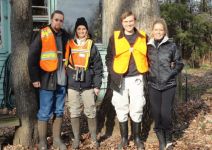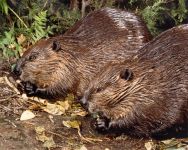


|

|
|
 
|
SUMMER OF VOLUNTEERS. Well it sure was a busy summer here at Unexpected – a summer of volunteers. As I mentioned in the last issue, we got hit pretty hard with the storm that smashed through South Jersey the last week in June. One thing is certain, we have some pretty great friends who always step up to help out when the chips are down (or rather when the trees are down!) Trail work began in earnest August 1, and our first recruit was my nephew, Manny Saad.
We hit the trail at Station 19, with a full array of equipment and worked our way to Station 17 over the course of several days. One afternoon, we were finishing up for the day at Station 18, stowing our tools and fuel under the big blue tarp, when the sky began to darken. We beat it all the way back to the truck at Squirrel Haven keeping in front of the front. The sky was purple and low, and we just made it into the cab and slammed the doors when the skies opened up with a fierce summer storm.
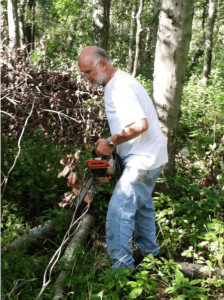
The devastation wrought by June's derecho (a widespread, intense windstorm) was so vast that the trails were impassible in places. After going about 200 feet down the trail with the mower or weed whacker, you had to switch over to the chainsaw to remove the next obstruction. The process was slow and laborious. In some places it was so hard to find the trail, you had to climb through or around the mess and approach it from the other direction. In most places, we were able to cut our way through the downed trees and restore the path to its original state, but in a few locations there were so many trees tangled up in one spot that we had to re-route the trail instead of removing the lumber. In addition to the appreciation for work performed by Manny, a big thank you goes out to Al Federici and Moe Bresser for their sawing expertise. Moe told me he could only give me two hours, but it would be a butt-kicking two hours (not his exact words). In two hours he and I cut up 12 downed trees lying in the trail from Station 12 to Station 11. It is amazing what two people can accomplish in a short period of time.
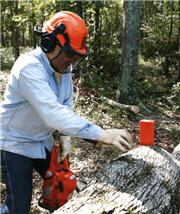
Of course we had a lot of help from folks who didn't run chainsaws. Volunteering here can take many forms, and all help is appreciated. Some like to work alone, like Jan, who comes with her loppers and enjoys her quiet time trimming trails and enjoying the forest. Jan has been helping out here for many years, as has Karen. Karen and I worked the trails some, but our bailiwick is splitting firewood. Since we killed our wood splitter last year, we borrowed Moe's this summer and put up several cords of wood for the coming cold weather. Manny threw in his hand here as well and gave me an afternoon of wood splitting.
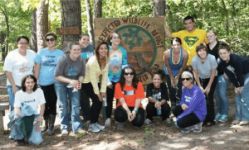
I recently met Andrew Perrone, Director of Rowan University's Service Learning, Volunteerism and Community Engagement Office. A huge part of his job is to connect the students at Rowan University with places to volunteer. Wow, what a great guy to know! Fifteen freshmen showed up in two vans to have a go at projects around the cabin in August. We spent a beautiful Thursday afternoon doing light trail maintenance, general clean up and a couple of gals repainted the outhouse. What a great group of young people who find volunteering to be a valuable part of their active lives. These kind of people make a difference in our lives.
RECENT PROJECTS. Our good friend and Beaver Defender Bob Bevilaqua came to the rescue again – he's the fellow responsible for resurrecting the driveway five years ago when it looked like the surface of the moon. After the storm, we developed a terrible erosion problem – the storm washed a lot of the driveway into the pond, leaving gullies, silting up the cove and leaving us exposed for more of the same with the next downpour. He and his crew brought in two truckloads of crushed stone and graded the driveway from in front of the cabin to the end of the barn, essentially stopping the unchecked runoff.
That weekend, Boy Scout Troop 65 came down for their 13th annual work/camp weekend. (Boy Scouts and wet concrete – oh my!) Nine Scouts participated in trail maintenance on the Perimeter Trail and Main Trail, and as you have read, that was no easy task. They worked most of Saturday and then set up their camp. They came back to the cabin and had their annual pumpkin carving contest, made dinner and then called it a night.
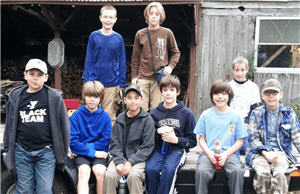
The beavers have not called it a night here at Unexpected. After our last issue, in which I described meeting the kittens and feeding the beavers on the Dike where they lived, we had many calls from folks who wanted to come and meet our little friends. Much to my embarrassment, I had to explain that Mom beaver had other plans for her family. It seems she was biding her time until the kittens were strong enough for an extended swim. In August, she relocated her family to a remote location upstream, just below Wild Goose Blind on the west end of the pond. The lodge is inaccessible to humans, but the beavers visit the Dike late at night and work on their dam, shoving mud and sticks under and on top of my wooden planks. I, on the day shift, pull mud and sticks from under and on top of my wooden planks. We had a lovely pre-Thanksgiving snow, and the lodge, very large and sturdy, stood out in stark contrast to a dark woody background. It would seem that we are all ready for the coming winter weather.
Jenny was leaning against my thigh and Jack was leaning against her. We all were leaning against the jam of the open kitchen door looking out the black porch windows into the raging storm. We were motionless, awed silent, and it seemed like we were all holding our breath–at least I was. Who knew where the cats were hiding. It was 1 a.m., hot and humid, and the power had just cut out. I was surprised that the power had stayed on as long as it had. The storm came out of nowhere and bore down on us with savage intensity. The only sound I had been able to hear for the last 30 minutes was howling wind and violent thunder all around. I got in the doorway when I heard, or rather felt, the crash. I knew as soon as I felt the house shudder that all or some of the tulip poplar or box elder had snapped off and landed right next to the cabin.
Even though I feared being smashed from above by more sailing lumber, I ventured into the living room and looked out the window, up to the electric lines that fed the house from the very last pole on the electric company's run. The sky above the storm was so pregnant with electrical mayhem that it strobed white flashes, illuminating the madness raging outside. It showed me clearly the powerless lines were still up and unbroken. For what it was worth, the fact that the now impotent wires still tethered us to the grid seemed to give me some weird sense of misplaced reassurance. I called the outage into the electric company on my cell phone, and the semi-human female voice measured out each word, telling me that. a. repair. ticket. had. been. made. and. power. would. be. restored. by. three. a.m. I looked at the dogs and whispered ‘not on your life.' I stifled a giggle and got back to the kitchen doorway with my two silent dogs ghosting my every move. Every time I thought the storm was letting up, it seemed to smash down harder on us. It was the most violent storm I have ever weathered.
The next morning the innocent dawn light showed a wasteland of vegetation. The ground was covered with tree tops, branches and debris as far as you could see. It took 30 minutes to clear a path from the cabin to the Miller House, and there it was the same–destruction. There were three trees down on the road out of the Refuge and one of them took the power and phone lines down with its last act. I went up on the cabin roof with the chain saw to cut up a 45-foot sumac, which did no damage–it just laid down. It uprooted, leaned over in the wind and stretched its length out along the ridge of the entire building roof. How kind!
The rest of the 1.2 square mile Refuge is much the same; trees down, branches down, roots up, however, thankfully no structures or vehicles were smashed. So now there is a lot of work to do out there. If you have a chainsaw, loppers, a pulse and spare time, please give me a call. I begin trail work in earnest August 1st, and it is going to be five times the usual amount of work to get the trails in shape for fall hiking. I can use all the volunteer help I can get this year so give me a call!
After having given no warning whatever, the weather forecasters called the storm a derecho, a word I had never heard in the meteorological realm, or any realm for that matter. Apparently, the word was coined by Dr. Gustavus Hinrichs in 1888. It describes a widespread, long-lived wind storm that is associated with a band of rapidly moving showers or thunderstorms...whatever it was no one told me it was coming, and I am embarrassed to admit I wasn't ready. The power was out for eight days, the longest I have ever been without electricity, except when I went camping. After the third day you start to reevaluate your lifestyle. What was it like to live 100 years ago? What is like to live in a land that doesn't provide electricity? Do I really need a refrigerator that size to keep my condiments cold? Ben Franklin once said ‘early to bed, early to rise..." for a reason–he liked to read. Do we really need all those electronic gadgets? Not that I have a lot of gadgets, I don't even own a microwave, but even after a few days I still found myself reaching for something that was totally useless without the help of Atlantic City Electric. And guess what? I lived.
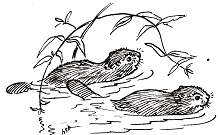
The beavers were fine with the derecho. Their home survived the winds, and no trees or branches toppled down upon it. One week after the storm blew through our sanctuary, mom brought out her kittens. She had three beautiful babies this spring, and they all came out to meet me. One in particular came right up to me and up out of the water. I laid my finger on his nose and stroked it. He sniffed a little apple wedge and gently took it. While he ate it, he let me pet his soft wet fur. His mother sat nearby with her eyes closed calmly eating her apple wedge.
The next night, I invited a new friend, Jimmy, to join me on the Dike to feed the beavers. He said okay, thinking, like most people who come to feed the beavers, that we would sit next to the pond and watch them out in the water swimming around. It was a lovely warm summer evening, and as the sun began its lazy descent toward the horizon, we unrolled the foam pad next to the water's edge and settled down to wait, cutting apples into quarters in anticipation of our furry dinner guests. Since Jimmy is very tall, he eventually stretched out on his side and propped himself up on his elbow–that placed him just slightly above beaver eye-level. To his utter amazement, the show began, and Jimmy was within an arm's length of mom beaver and three goofy little kittens.
The little ones put on a show for us, stealing apples from each other, pushing and shoving and squealing in protest. They first pestered mom for her treats but when she wouldn't share they would toddle on over to us with their little noses up. A sudden noise or movement would cause them all to flop themselves over into the water in juvenile tail slaps. They dove in all directions, with tiny little tails the size of serving spoons. Mom completely ignored the kittens' alarms (as most adult beavers do when kittens slap) and continued to eat unperturbed. One little kitten resurfaced from a comical dive with a mat of algae over her head and swam around like that until she dove again and it floated off. Enthralled, we sat next to the little beaver family until almost dark. We rolled up the pad and strolled back home through the sweet summer twilight. I do believe Jimmy is hooked.
White Bluebird Eggs
Bluebird eggs are usually blue however white eggs show up now and then and all eggs in the clutch will be white. These hatch into normally colored Bluebirds as is the female who laid them. Color (pigment) is added to the eggshell from cells/glands in the wall of the female's oviduct (the passage along which eggs travel). This does not happen with white eggs and it seems that a female that produces white eggs will always do so. I have monitored particular nest boxes with only white eggs two years running and all young fledged as normal Bluebirds. The white eggs seem to be as viable as the blue variety. It is somewhat of a surprise opening a nest box and seeing white eggs in a Bluebird nest. Two nests out of 68 had white eggs this year.
–Nels Anderson
Forest Harvest Program on State Land
Dear New Jersey Legislature:
The above signed* biologists, forest scientists, ecologists, and other land use researchers oppose the "Forest Harvest on State Lands" bill (S 1085) that has been re-introduced in the 2012 legislative session.
This forest harvest bill seems to have emerged from a two-pronged situation. The first is a desire to create new early successional habitats (shrubby meadows) for some game and rare non-game bird species, by extensively managing maturing, heavily forested lands for wood products, instead of restoring the ecological integrity of existing and plentiful early successional landscapes. The second is a "belief" that forests cannot prosper unless they are extensively harvested. This view is espoused by the president of the NJ Forestry Association in its Spring 2011 Newsletter that "a well-managed forest will go on forever, but a forest left to its own devices will die and become useless to anyone." This view is based simply on outdated, unscientific folklore. It was issued in response to Hunterdon County citizens voicing opposition to a timbering proposal for one of the county's oldest forest tracts, located on county parkland, ostensibly to make the forest "healthy."
As forest scientists, we all agree that our forests face many troubling issues. While our forests have important management needs, we do not believe that the remedy of choice to address our serious forest issues should be a massive harvest program that creates early successional habitat out of intact, closed-canopy, maturing forest. The focus for creating, restoring, and managing early successional habitat should be in existing but degraded young forests and recently-abandoned farmland habitats, where the negative effects of post-agricultural soils, alien species invasions, and the abundance of medium-size predators have led to the decline of many native species of early successional plants and animals.
In New Jersey, where unfragmented, contiguous, interior-forest conditions are declining and being degraded by overabundant deer and invasive species, a plan for early successional habitats to be hewn out of intact forest lacks scientific merit.
The forest harvest program described in this bill will make almost every existing forest problem worse:
We, the above-signed forest scientists, respectfully urge the legislature to oppose S 1085. Please do not move this bill forward. The challenges we face to restore our public forests are great, but extensive logging driven by an attempt to create a market for wood products is not the first place to turn for a science-based solution. We respectfully oppose this bill and would be pleased to discuss our most serious forest needs with members of the legislature at any time.
27 January 2012
*for a complete list of signers, see this document on the New Jersey Conservation Foundation website) (accessed 2016-01-27)
On Becoming The Beaver Lady or The Merkin
by Sarah Summerville
After I started working here at Unexpected, learning the ropes, Hope laid her hand on my arm one afternoon and told me we needed to have a "Talk".
Oh, oh. A Talk. We sat down together, and she very politely explained that as a Beaver Lady, I would be expected to go out and educate the public all about beavers. However, in my travels, I may come across some less than tactful or delicate individuals (more than likely they would be men) who would insist upon referring to women or a specific part of a woman, as beaver. I choked back a bark of a laugh and nodded, eyes down. I thanked her for the heads-up and told her to not worry for I would always have a sense of humor, and would not take it personally.
A friend of mine sent me a rather ‘racy' email joke about beavers. Contextually, it referred to the female of our species. I get a lot of this–funny bumper stickers, cards, refrigerator magnets–from folks who find this funny. It kind of comes with the territory.
So I was talking to my friend Maureen about this graphic email I got, and we started to kick around the reason WHY there was this persistent connection between beavers and the fair sex. We threw out some ideas of our own, and then she Googled it–turns out that there is a very specific reason why this reference exists.
It would appear that way back in the 1450's, prostitutes would shave to combat lice. They would then wear a merkin, which is a pubic wig, made of beaver fur. This fur piece was handy for covering up visual evidence of sexually transmitted diseases as well. These wigs were also donned by male actors, who in the day, also played female roles, including the scantily clad female parts (no pun intended). Today they are used extensively in movies to meet rating standards or to achieve the ‘hair style' of a time period.
Merkin. Now that's a word for the Scrabble board.
Beavers in Mourning
by Barry Wilson
I have been very fortunate to have been able to study beavers in the wild for over seven years. The main pod I have been working on is very small and it is impossible for a beaver to be in the pond but out of sight unless underwater.
I have been amazed at how gentle and close the family is. Nose touching seems to be a common occurrence between a mother and kits within the colony. I have even been honored to have three beavers in my first colony touch noses with me. Since I live alone, they became my family.
I took food in for them on a daily basis and on many occasions they would touch noses with me before taking an apple or poplar branch. I have photographs of this. I have had a wonderful time working with them and learned a great deal about their social life.
In the spring of 1987 I noticed that the behavior of the beavers in the pond had changed. They wouldn't come out for their treats and just floated around in the pond totally uninterested in the food and wouldn't come out of the water beside me. I thought that something had scared them. After about ten days things returned to normal. However, the yearling beaver was missing. I then thought that it had been killed. They had obviously gone through a period of mourning. About a week after the mourning process was over when I was going home I heard a splash in a small pond on the other side of the road. I went to investigate and found that the beaver called Explorer was there.
Each time a beaver left the colony this mourning was evident, sometimes this lasted longer than others.
The colony I am now studying is a descendent of that old original colony and is the same pond. Late last month the father of the colony was run over on the highway. All I found was his upper teeth embedded in the pavement. The mourning went on for a week, then Thumper, the mother, left the pond and probably returned to a nearby swamp. I returned from time to time and in a week she returned with the remainder of her family. The mourning continued. It is now August 26 and the mourning seems to be over. Last night she came up on the bank beside me for a fresh poplar branch. Some people say animals don't have feelings. I would like to know how they explain this.
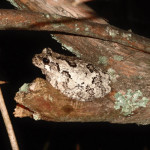
The hot dry April weather brought an explosion of colors and aromas to the Refuge. Some were early, some late and some right on time. The white flowering dogwood was one of Hope's favorite trees, and she relocated many of the specimens she found deep in the woods to places more visible from her home, here at the cabin. All along the driveway, around the house and well into Main Train, ethereal clouds of white blossoms float in and out of the deep green pines and the semi-bare trunks of the hardwood trees. They stretch their branches horizontally, vertically, twisting into elegant poses in an attempt to reach warm pools of sun beaming through the patchy canopy. When they are finished showing their spring glory, they, like the other blooming trees, release their beaten petals to the warm spring winds; mixing white heart shaped dogwood petals with pink tear drops from the redbuds, creating a forest floor littered with Mother Nature's confetti. A friend of mine said you can almost smell the sex in the air.
When I first came to Unexpected 12 years ago, my predecessor, Hope, was very ill, and home-bound much of the time. She often directed me from her bed, and in one instance told me to mow Squirrel Haven – the open area just before the Long Boardwalk. I completed my appointed task, but having more time, I continued to mow in other areas not included in Hope's instructions. During our nightly Scrabble game, I proudly described to her what I had done. She, feeling up to a walk the next morning, slowly made her way down the path to see my handiwork. Later that day, she told me how disappointed she was. I had inadvertently mowed down 12 tiny dogwood sets she had planted along the path the previous spring; they were as small as twigs. After that fiasco, I did exactly what she told me to do and curbed my enthusiasm for mowing willy nilly.
Construction abounds here – housing is going up everywhere! The beavers have relocated part of the family to a brand new lodge about 20 yards downstream from Wild Goose Blind. You cannot see it or get near it, but the beaver family must pass the blind nightly on their way to dine on alder and willow near the Long Boardwalk. Hope told me that beavers "cycle through" their environment. They eat all the food available in one area, then move out and relocate where there is fresh and plentiful vegetation. As time passes, the food grows back in the old stomping grounds and they then move back to their previous, now re-vegetated home. When I began working here they lived at the Long Boardwalk, but shortly thereafter had to move down below the Dike. I guess the larders are now full again, because they have moved back.
Prefabricated housing is also popular. Ole Don From Cherry Hill stopped by in March and installed a prothonotary warbler box next to the Long Boardwalk, and we cleaned out the other boxes that were along the water in anticipation of their return. According to Augie Sexauer, these warblers return on April 15th.
Hope always said bluebirds nest when dogwoods bloom. Bluebird Housing, the bird house company started years ago by Hope's older brother, Laurence Sawyer, sent us a new bluebird nest box for the cove and also contributed six new poles and predator guards for older existing boxes (www.bluebirdhousing.com). Although that box, meant for bluebirds, was commandeered by a very aggressive chickadee, Nels Anderson and I discovered a house with four baby bluebirds in it over on the new farm lands we acquired in 2009. Four tiny blind mouths reached toward us demanding sustenance immediately. We quickly retreated so Mom and Dad could do their never-ending job of feeding their young.
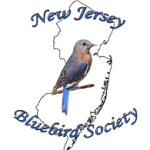
Speaking of Nels and bluebirds, thanks to him and his dedicated friends, there is now a New Jersey Chapter of the North American Bluebird Society. You can learn more about this great organization and join by contacting them at 498 Delaware Avenue, Egg Harbor Township, NJ 08234, or visit the website at www.njbluebirdsociety.org.
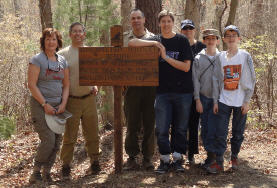
Adam Breskin from Boy Scout Troop 8, Cherry Hill, was our tenth scout to pursue the highest rank available in Boy Scouts of America – the rank of Eagle Scout. Adam tackled the entrance beautification project, stating that first impressions are everything. Adam makes a very impressive first impression himself, with a firm handshake and direct eye contact (with a small twinkle in that eye). He went to our list of available Eagle Scout projects on our website to find his project.
He made his decision in February and executed the fastest Review Board acceptance of any of our scouts yet. His team swooped in on a Saturday in late March, and with only a brief break for lunch under questionable skies, had 80 percent of the project done by quitting time. He returned to complete the project two weeks later. Adam and his crew removed truckloads of greenbrier, Japanese honeysuckle, Asian bittersweet and autumn olive. He took out some dangerous tree snags and repositioned the existing entrance sign to a more visible location. We extend a very generous thank you to Adam Breskin for choosing Unexpected Wildlife Refuge as host organization for his project and congratulate him on attaining this exalted rank.
Normally, my synopsis of our Earth Day Clean up would be in the July issue, but due to many reasons not under my control (and a few that were) this issue has been delayed from April to May. So, the day before Earth Day, 14 people came together at Unexpected Wildlife Refuge for the 12th year to make a difference on this planet. We split up into smaller groups and tackled a list of tasks which included the usual Piney Hollow Road trash party, but also included trail maintenance, trash pickup on Unexpected Road and digging out invasive plants along the driveway. Members of the Outdoor Club of South Jersey, Old Pine Farm Land Trust and Beaver Defenders all sat down at lunchtime to enjoy the repast that Maureen Koplow created and donated to the cause. The food was fantastic and the company was warm and welcome. A wonderful way to celebrate an idea created by Gaylord Nelson back in 1969 that has since morphed into a global event.
Frog Safari 2012, with Fred and Julie Akers
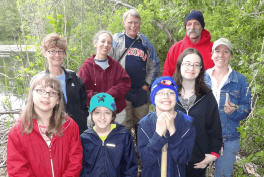
On a Saturday evening in early May, a small group of frog enthusiasts embarked on our annual Frog Safari. We all set out at dusk under a pleasant cloud-filled sky.
Our first stop was at the old beaver lodge on the Dike where we listened to carpenter frogs, cricket frogs and bullfrogs and watched the beavers. They dined on the apples we threw out into the cedar colored water as a good morning salutation. Although they have relocated upstream, they still use the old lodge as a hangout; a place to fraternize with the bipeds. Two yearlings and a very pregnant mom enjoyed their breakfast, and we proceed on to Muddy Bog.
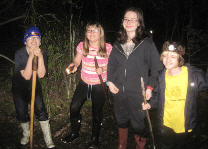
There the frogs were quiet, but we searched with our flashlights high and low through the dark wet bushes and branches surrounding the edges of the vernal pool. We successfully spotted and, or heard six more amphibian species: green, northern gray and chorus, spring peepers and lastly the Fowlers toad.
We all had a great evening and learned a lot from our leader, Fred Akers. A second follow-up visit will be in a month to see if the Pine Barrens tree frog is still present, since there were no calls or sightings of this threatened species of frog.
Happy New Year!
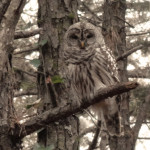
I recently read an article in Vegetarian Voice (Fall 2011) written by Mark Bekoff, PhD, entitled The Rich Emotional Lives of Animals: Scientific Validation. I found the study very interesting, but I think it is amazing that some people still think that humans have a monopoly on emotions. Just because they cannot speak our language, or because we can't speak theirs, does not mean that they are not like us. Recognizing human characteristics in animals is called anthropomorphism, and I have been doing this all my life.
Applying human characteristics to beavers is extremely easy. They are like humans in so many ways. Many Native Americans called beavers "little people" for this very reason. They, like humans, change their habitat to suit their needs, they mate for life and mourn their dead. They easily walk upright when working on their dams and lodges, arms loaded with sticks and mud. But personally, I think the kicker is their vocal repertoire – they talk to each other. All animals do, but beavers actually sound like they are having a conversation.
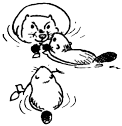
Years ago, one early summer evening, I sat on the Long Boardwalk next to a large beaver lodge. The whole beaver family came out for a snack with me. Well, almost the whole family. I had made friends with a family consisting of nine beavers – Mom, Dad, three one-year olds, and four kittens. At the time, I had not yet met the kittens, as they were not old enough to swim, and they were all still restricted to the "nursery" inside the lodge. Beaver kittens are born with fluffy air-filled fur that prevents them from sinking so they cannot drown. They practice swimming in their indoor swimming pool – the water inside the lodge where their family members come in and out. Next to this watery entrance is a "drying platform", used for just that. Then, on a higher shelf is the sleeping platform. They shred bark to pad this sleeping area with a soft mattress that they change often. Beavers are meticulous about their digs. No soggy beds! When the kittens are old enough, they will have built up the strength and stamina to dive and swim the entire length of the tunnel down, down, down, out into the pond.
The parents and their three yearlings, one of whom I had named Earnest, were all hanging around with me. They were not there just to enjoy my engaging presence. I had brought a bundle of poplar branches and apples, and everyone was eating loudly, enjoying their take-out. Crunching and munching and chewing on bark and leaves, Mom floated off to my left, Earnest was perched on a well-submerged log far to my right, and the other three family members floated in various spots between those two. Everyone had plenty of elbow room in the warm cedar-colored water.
Amid all this audible feasting, we suddenly had an unexpected visitor. POP! Right in the middle of this there appeared a tiny brown beaver kitten. You could tell just by his overwhelmed look that this was his first visit to the outside world. Bewildered, he bobbed there in the water, like a fuzzy cork.
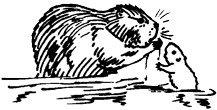
His mother, unhappy about his unauthorized release from within, became agitated and started to hiss and blow. When angry or provoked, beavers make some very interesting sounds, like blowing across the top of a bottle. Although she did not stop enjoying her delicacies, she began to make a terrible fuss. His mother's anger trumped his surroundings, and Cork decided he had better get back to bed with his other siblings. He ducked his head down in a pathetic dive, showing his teensy paddle tail and useless feet. Unfortunately, when young Cork had so boldly left the safety of his lodge, he had been perched on the drying platform – which was higher than the water's surface. Now that he was IN the water, he could not get any force behind his dive. So with each attempt, he would pop back up, like a cork. Frustrated, defeated and more than a little terrified by his rumbling mother, Cork gave up his diving and toddled over to Earnest. He began to loudly whine, mew and pull on his brothers soft, wet fur. Earnest would have none of it. He had his long luscious stick of poplar, thick with green sappy leaves, and he was enjoying the sticky strips of bark that he pulled from the branch. Whimpering over his mother's tirade, Cork kept harassing Earnest for help. Earnest yanked away, twisting this way and that, trying to extract his furry ‘sleeves' from Cork's desperate grip.
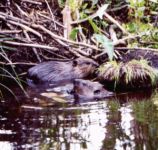
Finally, in obvious disgust, Earnest literally threw his poplar branch down into the water and slid off his stump into the water. Cork latched onto his brother's neck with his tiny hands and held on tight while Earnest swam to the point in the water where Cork had originally surfaced.
With Cork's little fingers tangled into the fur around his neck, Earnest dove expertly into the depths of the pond. Seconds later, there was the faint sound of water breaking inside the lodge and then soft cooing and mewing from the two wet beavers together with the sounds of the other more obedient babies, hungry for adult attention. This went on for awhile as Earnest settled the babies, and then there was another gentle splash and gurgle.
Then, up popped Earnest all alone. He swam around a bit surveying his family, starting with his mother, and then, satisfied that everyone was okay, he returned to his feast. He picked up his abandoned poplar branch and resumed snacking. His mother had quieted as soon as Earnest and Cork dove. She had left the water and sat on a flattened tuft of sedge, grooming herself, quite content with the restored peace and quiet.
A SPECIAL SHOUT OUT to those of you who helped patrol during the 2011-2012 deer hunting season. We had some new faces show up this year, with Phil, Anna, Cara, Wayne, Bob and Theresa. Our regular team helped make them feel right at home. Thanks also to Dan, Melissa, Roger, Jan, Chris, David, Maureen, Paula, Leona, George, Candy, Nancy, Sally, Moe, Freya, Anne, Clint, Mary Ann, Nels, Al, Karen, Gene, Erin, Greg, Leroy, Thea, Bill, Doug AND Pat!
A special thanks to Phil for providing me with a week of guilt-free writing – priceless!
